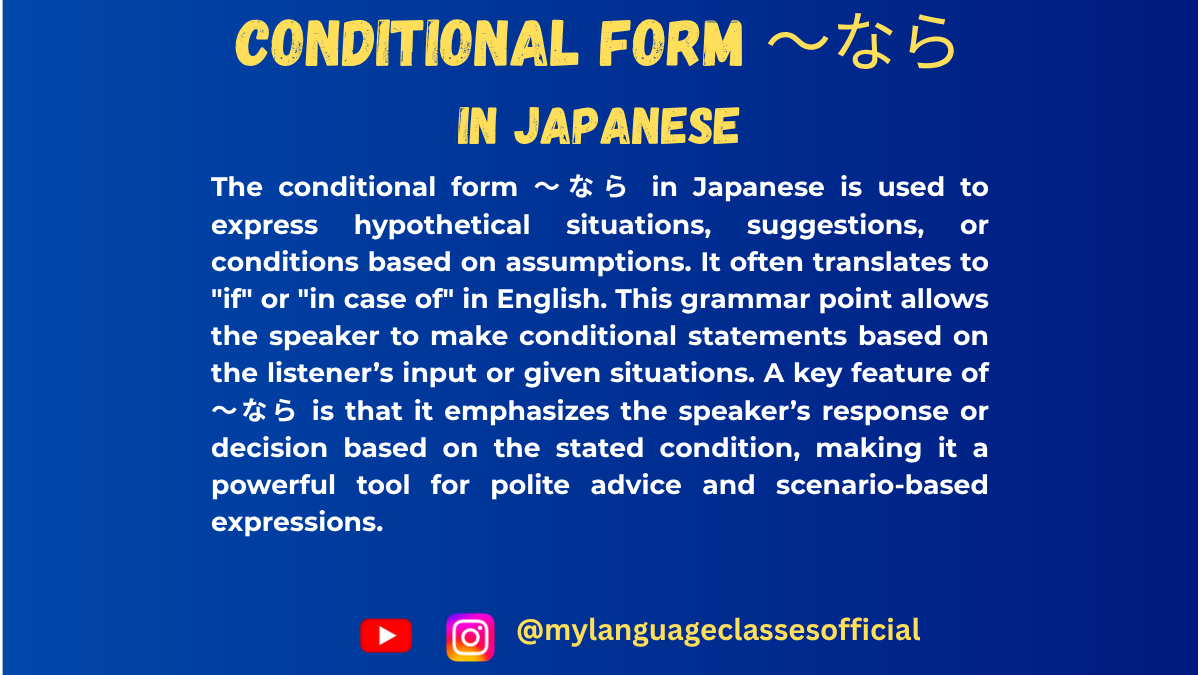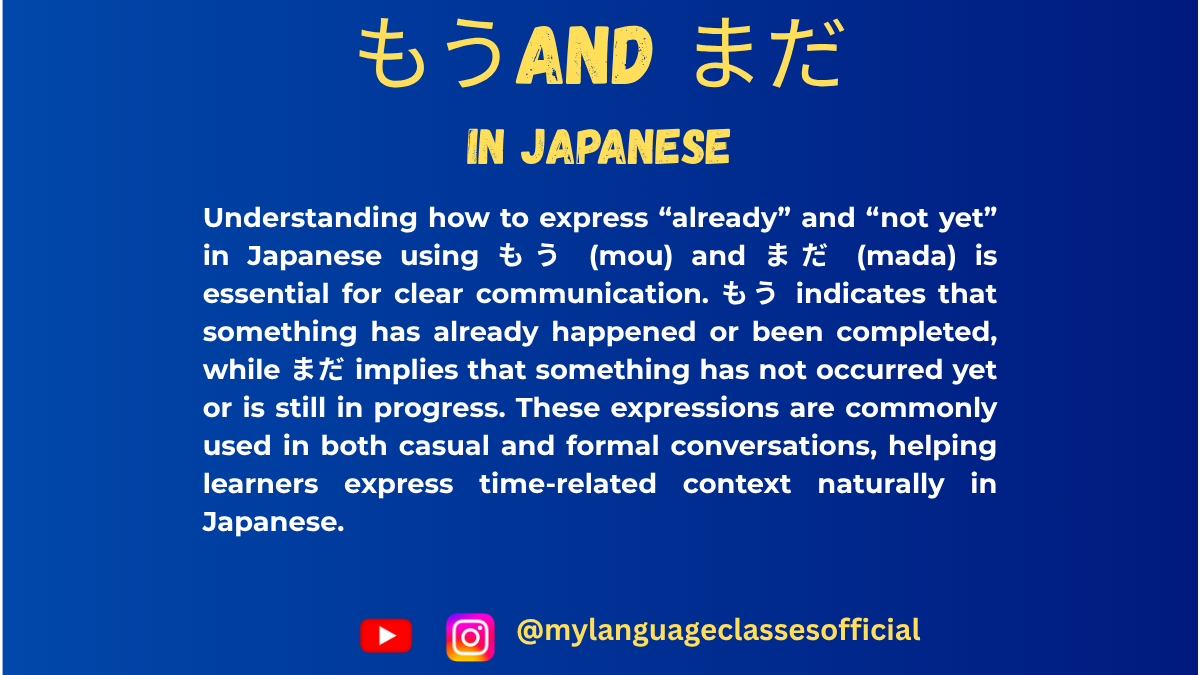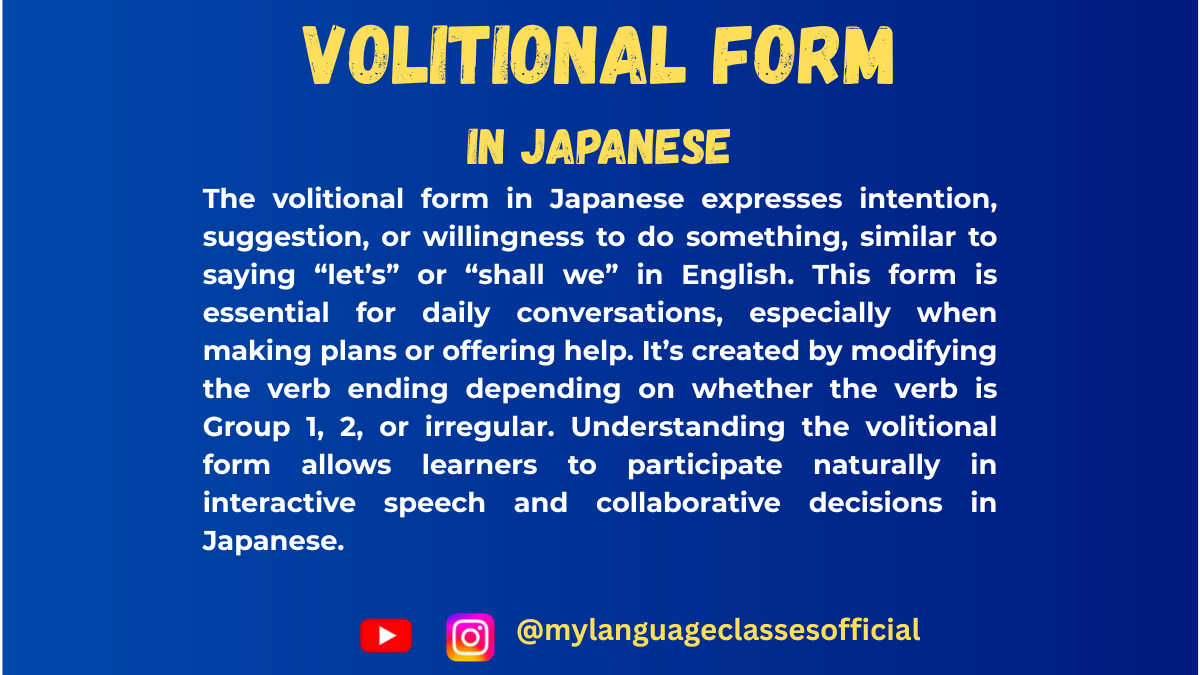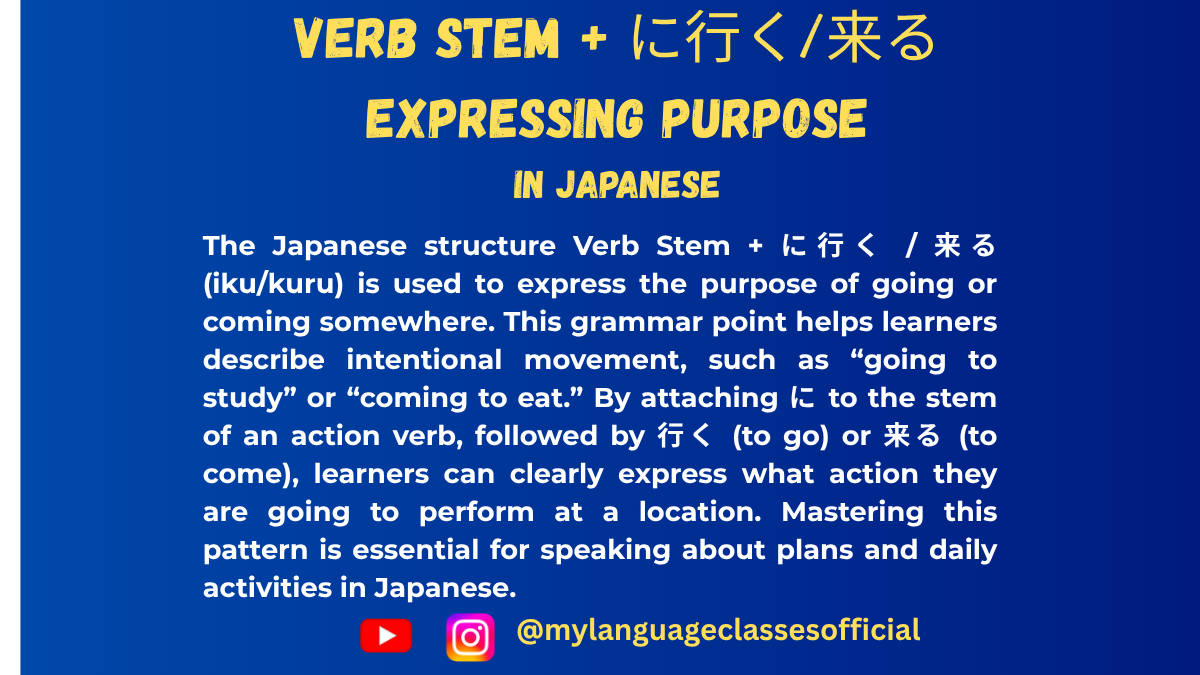Your cart is currently empty!
Tag: Japanese grammar for beginners
-

Using 〜なら for hypothetical situations | My Language Classes
〜なら: Expressing “If” or “As for” in Japanese
In Japanese, 〜なら is a versatile grammar structure often used to express conditionality (“if”) or to provide contextual emphasis (“as for”). This blog post will explore its usage in various contexts and provide a comprehensive list of situations where 〜なら is applicable.
What is 〜なら?
The particle なら is derived from the verb 成る (なる), which means “to become.” In grammar, it functions as a conditional marker or a topic-related particle depending on the context. It is commonly attached to the plain form of verbs, nouns, or adjectives.
Usage of 〜なら
1. Conditional “If”
- Meaning: Expresses a hypothetical or conditional situation.
- Structure:
Clause A (plain form) + なら, Clause B
Clause B often represents the speaker’s judgment, advice, or consequence.
Examples:
- 日本に行くなら、富士山を見たほうがいいですよ。
(Nihon ni iku nara, Fujisan o mita hō ga ii desu yo.)
If you’re going to Japan, you should see Mt. Fuji. - 雨が降るなら、外出しないほうがいいです。
(Ame ga furu nara, gaishutsu shinai hō ga ii desu.)
If it rains, you shouldn’t go out.
2. Topic-Based “As for”
- Meaning: Indicates that a specific topic is being addressed in response to a preceding statement or question.
- Structure:
Noun + なら
Examples:
- 映画なら、コメディが一番好きです。
(Eiga nara, komedi ga ichiban suki desu.)
As for movies, I like comedies the best. - この本なら、もう読んだことがあります。
(Kono hon nara, mō yonda koto ga arimasu.)
As for this book, I’ve already read it.
3. Contrasting Ideas
- Meaning: Suggests a contrast between two different ideas or topics.
- Structure:
Noun/Adjective/Verb + なら
Examples:
- 英語なら話せますが、フランス語は話せません。
(Eigo nara hanasemasu ga, Furansugo wa hanasemasen.)
If it’s English, I can speak it, but I can’t speak French. - 安いなら買いますが、高いなら買いません。
(Yasui nara kaimasu ga, takai nara kaimasen.)
If it’s cheap, I’ll buy it, but if it’s expensive, I won’t.
4. Hypothetical Suggestions
- Meaning: Used when giving suggestions or advice based on hypothetical conditions.
- Structure:
Clause + なら
Examples:
- 東京に行くなら、スカイツリーを訪れるべきです。
(Tōkyō ni iku nara, Sukaitsurī o otozureru beki desu.)
If you’re visiting Tokyo, you should check out the Skytree. - 勉強するなら、早めに始めたほうがいいですよ。
(Benkyō suru nara, hayame ni hajimeta hō ga ii desu yo.)
If you’re going to study, it’s better to start early.
5. Clarifications or Conditions
- Meaning: Used when responding to a condition or clarifying information.
- Structure:
Noun + なら
Examples:
- 山田さんなら、もう帰りましたよ。
(Yamada-san nara, mō kaerimashita yo.)
If you’re talking about Yamada-san, he’s already gone home. - 駅なら、この道をまっすぐ行けば着きます。
(Eki nara, kono michi o massugu ikeba tsukimasu.)
If you mean the station, go straight down this road.
When to Use 〜なら?
Here is a quick checklist of situations where 〜なら is appropriate:
- Making a Hypothetical Conditional Statement:
“If you’re going to X, then Y.” - Responding to Questions or Comments with Context:
“As for X, Y applies.” - Contrasting Two Scenarios or Topics:
“If X is true, Y. But if not, Z.” - Providing Advice Based on Hypothetical Situations:
“If you’re considering X, then Y is a good idea.” - Clarifying or Confirming a Specific Topic:
“If you’re talking about X, then Y.”
Tips for Using 〜なら
- Be Contextual: 〜なら thrives on context. Make sure the listener understands the implied condition or topic.
- Be Specific: Use it to address clear contrasts or hypothetical situations, avoiding vague statements.
- Practice Intonation: When using 〜なら in spoken Japanese, emphasize the conditional tone to make your intent clear.
By mastering 〜なら, you’ll find yourself able to express conditions, offer advice, and clarify topics more effectively in Japanese. Practice by creating your own sentences in real-life scenarios!
If you enjoyed this lesson, be sure to check out more posts like this on my blog at My Language Classes. Don’t forget to subscribe my YouTube channel and follow me on Instagram for the latest language learning tips and lessons. Leave a comment below to share your thoughts, or ask any questions you have about nouns.
Happy learning! 😊
-

Expressing “without doing” in Japanese: 〜ないで | My Language Classes
Using 〜ないで in Japanese
Learning how to express “without doing” in Japanese is essential for mastering natural and nuanced communication. The grammar structure 〜ないで (“〜naide”) is a versatile and commonly used expression in Japanese that allows speakers to convey the idea of “not doing something” or “without doing something.” In this blog post, we will explore the various situations where 〜ないで is used, its nuances, and how to incorporate it into your conversations.
What is 〜ないで?
〜ないで is the negative て-form of a verb. It attaches to the plain negative form (〜ない) of a verb to indicate actions that are not done or states that are avoided. Depending on the context, 〜ないで can:
- Express doing something without performing another action.
- Serve as a request or instruction not to do something.
- Indicate cause and effect, such as when one action was done because another was avoided.
Usage of 〜ないで
1. Expressing “without doing something”
This is the most common usage, where 〜ないで describes an action performed in the absence of another action.
- Structure: 〜ないで + another verb/action
- Examples:
- 家を出る前に朝ごはんを食べないで行きました。 (Ie o deru mae ni asagohan o tabenai de ikimashita.) “I left the house without eating breakfast.”
- 仕事を終えないで帰ってはだめです。 (Shigoto o oenai de kaette wa dame desu.) “You shouldn’t go home without finishing your work.”
2. Giving instructions or making requests
When used as a standalone phrase, 〜ないで acts as a direct or polite request not to perform a certain action.
- Structure: Verb (negative form) + ないで
- Examples:
- 詐欺にないで下さい。 (Saguni nai de kudasai.) “Please don’t lie.”
- ここですわらないで。 (Koko de suwaranai de.) “Don’t sit here.”
3. Cause and effect
In some cases, 〜ないで implies that a subsequent action happened because the preceding action was avoided.
- Structure: Verb (negative form) + ないで
- Examples:
- 「話しないで気づいてくれた。」 (Hanashinaide kidzuite kureta.) “They noticed without me saying anything.”
- 親に聞かないで自分で決めました。 (Oya ni kikanaide jibun de kimemashita.) “I decided on my own without asking my parents.”
4. Contrastive emphasis
Here, 〜ないで can emphasize a contrast between what is done and what is not done.
- Structure: 〜ないで + another clause/action
- Examples:
- さんぽを買わないで、アイスを買いました。 (Sanpo o kawanai de, aisu o kaimashita.) “I didn’t buy a sandwich; I bought ice cream instead.”
- 電車で行かないで、歩きました。 (Densha de ikanai de, arukimashita.) “I didn’t take the train; I walked instead.”
Situations Where 〜ないで is Used
- Describing actions done without another action:
- Leaving the house without eating.
- Traveling without packing necessary items.
- Making polite or casual requests:
- Asking someone not to smoke.
- Requesting someone to stay quiet.
- Cause and effect relationships:
- Explaining results stemming from avoiding an action.
- Contrasting actions:
- Highlighting differences between what was done and what wasn’t.
- In storytelling or hypothetical scenarios:
- Creating imagery of what happens when an action is avoided.
Important Notes on 〜ないで
- Formality: 〜ないで is appropriate in both casual and polite speech, but ensure you adjust the overall sentence to suit the context.
- Difference from 〜なくて: While both 〜ないで and 〜なくて convey negation, 〜ないで is specific to “without doing” or “don’t do,” whereas 〜なくて often implies “because not doing.”
- Example:
- 食べないで出かけた。 (“I went out without eating.”)
- 食べなくて出かけた。 (“I went out because I didn’t eat.”)
- Example:
- Verb nuance: The preceding verb influences the meaning and nuance of 〜ないで. Contextual understanding is crucial.
Practice Exercises
Try these sentences to solidify your understanding:
- Translate: “Please don’t run in the hallway.”
- Fill in the blank: 仕事をしないで、\u___。 (Hint: “Relax at home.”)
- Explain the difference in nuance between しないで and しなくて in a given context.
Mastering 〜ないで expands your ability to express nuanced actions and instructions in Japanese. With practice, you’ll find this structure indispensable in your language toolkit. Happy learning!
If you enjoyed this lesson, be sure to check out more posts like this on my blog at My Language Classes. Don’t forget to subscribe my YouTube channel and follow me on Instagram for the latest language learning tips and lessons. Leave a comment below to share your thoughts, or ask any questions you have about nouns.
Happy learning! 😊
-

How to Say “Already” & “Not Yet” in Japanese もう and まだ | My Language Classes
Expressing “Already” and “Not Yet” in Japanese
When learning Japanese, one of the first challenges is understanding how to express “already” and “not yet.” In English, these concepts are simple, but in Japanese, we rely on two essential words: もう (mou) and まだ (mada). By the end of this post, you’ll master how to use these two expressions correctly and naturally.
1. Understanding もう (“Already”)
The word もう translates to “already” in English and is used to indicate that an action has already been completed or a state has been reached.
Examples of もう in Sentences
- もう食べました。
Mou tabemashita.
“I already ate.” - もう終わりましたか?
Mou owarimashita ka?
“Have you already finished?” - 彼はもう来ました。
Kare wa mou kimashita.
“He has already come.”
Key Point for もう:
- Use it with the past tense of a verb to show completion.
- It often expresses a sense of surprise or confirmation.
2. Understanding まだ (“Not Yet”)
On the other hand, まだ means “not yet” and expresses an action or state that has not happened or is still ongoing.
Examples of まだ in Sentences
- まだ食べていません。
Mada tabete imasen.
“I haven’t eaten yet.” - まだ終わっていない。
Mada owatte inai.
“It’s not finished yet.” - 彼はまだ来ていません。
Kare wa mada kite imasen.
“He hasn’t come yet.”
Key Point for まだ:
- Use it with the negative form of a verb.
- It implies that something is expected to happen or still in progress.
3. Using もう and まだ Together
To create a clear contrast, you can use もう and まだ in conversations:
- もう食べましたか?
Mou tabemashita ka?
“Have you already eaten?”- Answer (Yes): もう食べました。(Mou tabemashita.) – “I already ate.”
- Answer (No): まだ食べていません。(Mada tabete imasen.) – “I haven’t eaten yet.”
This contrast helps clarify whether something has already occurred or is still pending.
4. Common Expressions Using もう and まだ
Here are a few handy expressions that use these words:
- もういいです。 (Mou ii desu.) – “It’s okay now.” / “I’m done.”
- まだまだです。 (Mada mada desu.) – “I still have a long way to go.” (Often used humbly about one’s skills or progress.)
5. Summary: Quick Reference Table
Word Meaning Usage Example もう Already Past/Complete Actions もう行きました。 (Mou ikimashita.) – “I already went.” まだ Not Yet/Still Negative or Ongoing まだ行っていません。 (Mada itte imasen.) – “I haven’t gone yet.”
6. Practice Time!
Try filling in the blanks with もう or まだ:
- ( )宿題を終えましたか? (… shukudai o oemashita ka?)
“Have you finished your homework already?” - いいえ、( )終わっていません。
“No, I haven’t finished yet.”
Answers:
- もう
- まだ
By practicing もう and まだ, you’ll gain confidence in expressing whether something has “already” happened or “not yet.” Keep listening to native speakers and trying these phrases in daily conversation—まだまだ there’s plenty to learn, but you’re already doing great!
What do you think about these tips? Let me know if you もう understand or if you’re まだ unsure—leave a comment below! 😊
If you enjoyed this lesson, be sure to check out more posts like this on my blog at My Language Classes. Don’t forget to subscribe my YouTube channel and follow me on Instagram for the latest language learning tips and lessons. Leave a comment below to share your thoughts, or ask any questions you have about nouns.
Happy learning! 😊
- もう食べました。
-

Understanding Volitional Form in Japanese | My Language Classes
Volitional Form in Japanese
The volitional form in Japanese is a versatile and essential grammatical structure. It’s often used to express intentions, suggestions, or invitations. Think of it as the Japanese equivalent of saying, “Let’s” or “Shall we?” in English.
This post will break it down into two main categories: the informal volitional form and the polite volitional form, making it easy for learners of all levels to grasp and apply.
1. The Informal Volitional Form
The informal volitional form is used casually among friends, family, or people you’re close to. It’s the shorter, more relaxed version of suggesting something.
How to Form It
The structure depends on whether the verb is a う-verb or a る-verb. Here’s how you can form the volitional form:
- For う-verbs: Replace the final う sound with おう.
- Example:
- 行く (iku – to go) → 行こう (ikou – Let’s go)
- 飲む (nomu – to drink) → 飲もう (nomou – Let’s drink)
- Example:
- For る-verbs: Drop the る and add よう.
- Example:
- 食べる (taberu – to eat) → 食べよう (tabeyou – Let’s eat)
- 見る (miru – to see/watch) → 見よう (miyou – Let’s watch)
- Example:
- Irregular verbs: These don’t follow the usual patterns and need to be memorized:
- する (suru – to do) → しよう (shiyou – Let’s do)
- 来る (kuru – to come) → 来よう (koyou – Let’s come)
When to Use It
Use the informal volitional form in casual contexts:
- Planning something with friends:
- 映画を見よう! (Eiga o miyou! – Let’s watch a movie!)
- Deciding something for yourself:
- もっと頑張ろう。 (Motto ganbarou. – I’ll try harder.)
2. The Polite Volitional Form
For more formal situations, the polite volitional form is used. This is especially common in workplaces, public settings, or when speaking to superiors or strangers.
How to Form It
The polite volitional form follows a straightforward rule:
- Take the stem of the verb and add ましょう.
- Example:
- 行く (iku – to go) → 行きましょう (ikimashou – Let’s go)
- 食べる (taberu – to eat) → 食べましょう (tabemashou – Let’s eat)
When to Use It
Use the polite volitional form in formal or respectful contexts:
- Inviting someone politely:
- 一緒に昼ご飯を食べましょうか? (Issho ni hiru gohan o tabemashou ka? – Shall we have lunch together?)
- Offering a suggestion in a business setting:
- 次のステップを考えましょう。 (Tsugi no suteppu o kangaemashou. – Let’s think about the next step.)
3. Key Differences Between Informal and Polite Forms
Aspect Informal Volitional Form Polite Volitional Form Tone Casual Formal/Respectful Ending おう/よう Verb stem + ましょう Usage Context Friends, family Business, public, formal
4. Practice Makes Perfect!
Here are a few sentences to test your understanding. Try converting them into both informal and polite volitional forms:
- 泳ぐ (oyogu – to swim)
- 話す (hanasu – to talk)
- 勉強する (benkyou suru – to study)
Answers:
- 泳ぐ: 泳ごう / 泳ぎましょう
- 話す: 話そう / 話しましょう
- 勉強する: 勉強しよう / 勉強しましょう
By mastering the volitional form, you’ll be well on your way to expressing intentions and making suggestions naturally in Japanese. Practice using these forms in conversations, and soon they’ll become second nature. 頑張りましょう! (Ganbarimashou! – Let’s do our best!)
If you enjoyed this lesson, be sure to check out more posts like this on my blog at My Language Classes. Don’t forget to subscribe my YouTube channel and follow me on Instagram for the latest language learning tips and lessons. Leave a comment below to share your thoughts, or ask any questions you have about nouns.
Happy learning! 😊
- For う-verbs: Replace the final う sound with おう.

